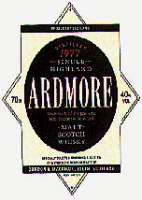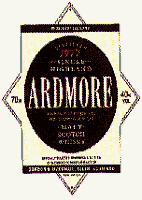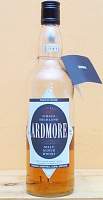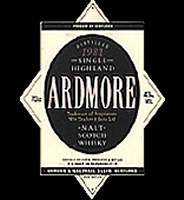

ARDMORE
| Location : | By Kennethmont, 27km south of Huntly, Aberdeenshire, Grampian Region. - Situated alongside the Aberdeen to Inverness railway line, below the Knockandy Hill. Close by is Leith Hall. |
| Region : | Highland Speyside (North-east). (Bogie) / North East Scotland |
| Country : | Scotland |
| Type : | Malt |
| Distillery : | Ardmore Distillery Kennethmont, Huntly, Aberdeenshire, AB54 4NH Phone : +44 0-1464 831213 Fax : +44 0-1464 831428 No visitorcentre :: \L\1br> Manager : Iain Henderson |
| Founded : | in 1891 By William Teachers Sons, and built in 1898 Expanded in 1955 and 1974. |
| Owner : | Allied Distillers Ltd. A part of Allied Domecq. |
| Producer : | Allied Distillers Ltd. |
| Water : | Springs from Knockandy Hill / A spring on Knockandy Hill. |
| Remark : | Ardmore is used in the Teacher's blends Known as 12 or 18 Years Old or vintage Vol : 46% Ardmore Distillery has preserved the original steam engine and coal-fired stills. Here is a rip from Ardmore Distillery is located near the ancient villages of Spynie and Kennethmont in rural Aberdeenshire. It was established by William Teacher in 1898 in response to the 1890's whisky boom. It is a staple in his successors' blended whisky, Highland Cream. The distillery originally had only two stills but two additional stills were added in 1955. The stills were increased to eight in 1974. An "official" bottling of Ardmore single malt is very rare but independent bottlings can be found from time to time. Remark from Gordon & MacPhail Situated at Kennethmont by Huntly, Ardmore produces a full-bodied Highland whisky. Its rich smoky character is a vital component of Teachers Blended Whisky. As a single malt it has a depth and a complexity which make it an ideal after dinner drink. Ardmore is not widely known as a single malt, but its qualities as such were endorsed earlier this year when it received recognition as 'highly recommended' in a Blind Panel Tasting held by Decanter Magazine. With its pungent peaty taste, Ardmore has always been a vital element in a famous and distinguished blended Scotch Whisky, Teachers Highland Cream and, as we discovered during our visit to the distillery, almost all of its production does actually go for blending. Fortunately, with the authority of the distillery owners, Allied Distillers, some of this distinctive whisky is bottled and sold as a single malt by Gordon & MacPhail. Ardmore comes from a distillery set deep in the hills of Aberdeenshire, close to the village of Kennethmont. The rolling hills in this area are covered with fertile farm land. The elegant National Trust Leith Hall is situated on the outskirts of Kennethmont and the main railway line from Inverness to Aberdeen runs beside the distillery itself. It was William Teacher's son, Adam who organised the construction of Ardmore in 1898. These were the years when there was a boom in the whisky industry. Over the intervening years Ardmore has continued to prosper and is now one of the larger and most modern Scotch Whisky distilleries, with a total capacity reaching some three million litres. Walking around the distillery, there are a great many reminders of the past. The original steam engine, that used to power the whole operation, still stands proudly gleaming, somewhat incongruous, behind the modern malting plant used to grind the grain. Mounted on the wall in the Mash Room, is the side plate of the distillery's original mash tun, while the walls of the Manager's office are decorated with the portraits of the original workforce. When the distillery was established and for many years thereafter, supplies of barley and coal were transported to the distillery by rail. The distillery had its own siding which was also used to load the casks of mature whisky when they were being dispatched to Teachers in the south. Today some of the buildings which formed the station still stand and mark a bygone era. Ardmore draws its water from 14 springs on the Knockandy Hill, which lies to the south of the distillery, cooling water comes from the burns nearby. Until the late 1970s, barley was malted at the distillery itself, but in recent years supplies have come from local commercial maltsters. The fuller more pungent flavour of the whisky produced here, in contrast to many other Highland malts, is due to the relatively high peating levels of the barley. Malt storage is about 1,000 tonnes and the traditional copper domed mash tun of a notable 25 feet in diameter mashes 12.0 tonnes. There are 14 wooden wash backs, which have a total capacity of 90,000 litres. The wash remains here for approximately 48 hours until the fermentation process is complete and is then fed to the four wash stills. Ardmore was initially built with two stills, it was extended in 1958, when a further two stills were added. In 1975, the capacity was doubled with another four stills, all copies of the original stills. The still room today is the distillery's pride and joy and the reasoning for this becomes self-evident. Viewed from the high-level entrance to the still room, the stills present a magnificent sight - a row of eight elegantly shaped copper stills, each with an equal capacity of 15,000 litres. The spirit stills vary slightly in shape from the wash stills in that they have a slightly taller neck. One of the most striking factors about this still room, however, is that the stills are heated in the traditional manner, direct with coal furnaces. This is quite unusual as there are not many distilleries remaining now which use coal. The stills have thick bases and chain rummagers inside which stop the content from burning. The condensors are situated inside the still house and a heat recovering system has been in operation for many years. The old distillery maltings have been converted into a filling store. Casks are stored in the extensive warehouses which are adjacent to the distillery. From the old maltings, our tour took us to the cooperage - another memorable part of our visit to Ardmore. The distillery has its own cooperage, where casks are prepared prior to filling with new whisky. On occasions this entails the firing or char-ring of the inside of the cask to help with the maturing of the whisky. The fact that Ardmore is very much a traditional distillery was evident throughout our visit - even to the point of the customary distillery cat - this one being three legged - warming itself by the heat of the glowing coals in the still room. But perhaps the reminders of the past that are found all over the distillery are significant in so far as they suggest a continued commitment to the quality of fine malt that has been produced there for so many years. From the book 'The Scottish Collection' Classic malts by Carol P. Shaw: Tasting notes : A full-bodied Speyside malt wich is both robust and sweet. An ideal after-dinner dram, although it is not easy to come by; available as a single malt only through independent bottlers. Tasting rating = 4 The distillery at Ardmore was built in 1898 by the Teacher family of whisky merchants and blenders. Since that time almost all its production has gone into Teacher's blends, most famously Highland Cream. Today it is operated by Allied Distillers, so its product also features prominently in Allied's other belnds. Although the distillery has been modernized it still retains some of the original equipment, such as coal-fired stills, which were used in the production of whisky at the end of the nineteenth century. From the Whisky pilot by Uniqum Systems : Ardmore distillery was founded in 1898 by Wm. Teacher, on the Eastern edge of Speyside at Kennethmont. The distillery was built as part of a major expansion programme for the company's popular blended whiskies. Originally it featured to two stills but has doubled in size twice - four stills in 1955 and eight stills in 1974. Just one year after it being built the whisky market collapsed due to over supply, but Ardmore survived, much due to the fact that it was built to maintain malt supplies for Teachers' Highland Cream. Today, the distillery is operated by Allied Distillers Ltd, a part of Allied Domecq. The stills are still coal fired and the steam engine, boiler front and other relics of the original distillery are preserved. Currently one of the largest malt whisky distilleries in Scotland. Ardmore is from the Gaelic word, Ard-moi, which means `big-slope'. Ardmore is situated alongside the Aberdeen to Inverness railway line, below the 1,425 ft Knockandy Hill. Close by is Leith Hall. The water is taken from a spring on Knockandy Hill. |
| Ardmore 1977 Gordon & MacPhail | |
 | |
| Age : | Vintage 1977 |
| Vol : | ?% | Price : | ? |
| Remark : | None at present time... |
| Ardmore 1981 Gordon & MacPhail | |


 | |
| Age : | Vintage ? |
| Vol : | ?% | Price : | £27.00 at Ardmore 1981 half bottle £14.00 Ardmore Gordon & MacPhail vintage 1981/95 40% vol. 78,50 DM at The Whisky StoreThe Whisky Store : \L\1ermany) Ardmore Miniature 5cl. 1981 Gordon & MacPhail 40% vol. 12,00 DM. Ardmore : \L\1&M) Single Malt vin. 1981 Scotland Highland 35 cl. 40% 245,00 Dkr in Skjold Burne (Tidligere Amager Vincenter). |
| Remark : | None at present time... |
| LINKS.......... | to other Ardmore related web pages. |
| URL : |
| Here's a request from Mr.: George
D. Morris
This past summer I tried a bit of Ardmore 12 year old while in the UK, and found it superb. Upon returning to the US I tried to find it at a Pennsylvania State Store. An employee checked a book and informed me that it is not imported into the United States. Is he right? If not could you advise where I should look? Many thanks for your help. George D. Morris orbits@nauticom.net |
| http://www.awa.dk | Site made by |